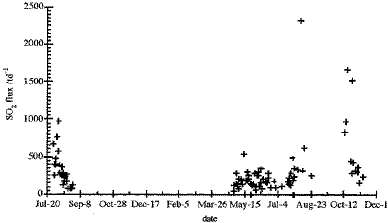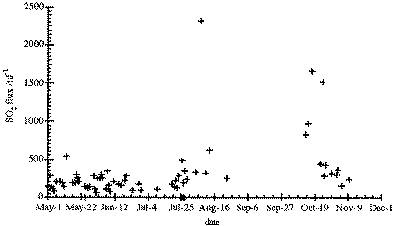
MVO/VSG - Open Scientific Meeting
27 November 1996
COSPEC and FTIR Monitoring of Plume Gases From Montserrat
C. Oppenheimer1, P.W. Francis2, A. Maciejewski2, S.R. Young3, G.E. Norton3, B. Darroux4, & R. Robertson4

C. Oppenheimer1, P.W. Francis2, A. Maciejewski2, S.R. Young3, G.E. Norton3, B. Darroux4, & R. Robertson4
1Department of Geography, University of Cambridge
2Department of Earth Sciences, Open University
3British Geological Survey, Keyworth
4Montserrat Volcano Observatory, Montserrat
COSPEC measurements of SO2 fluxes at Montserrat were carried out during the early phases of the crisis in 1995; were resumed in April 1996, and have been carried out routinely since then, subject to interruptions due to instrumental problems and unsuitable weather. A MiniCOSPECTM manufactured by Barringer Research and provided through a NERC emergency grant was commissioned in late July 1996 and has been operating successfully. Many individuals involved with the Montserrat effort contributed to the compilation of the data set. FTIR measurements of gas compositions was initiated in May 1996 on an experimental basis, and continued in August.
COSPEC
The Correlation Spectrometer estimates atmospheric SO2 concentrations by determining the absorption of solar ultraviolet radiation in transmission through the plume. It has provided a standard tool for volcanology since the 1970s because increases of SO2 flux provide prima facie evidence of the approach of bodies of new magma to the surface. It is also a relatively simple and robust instrument, providing near real-time data. Results are often reported, however, without analysis of errors, which can be large. Apart from instrumental errors, these include errors in wind speed and plume width determinations, and errors introduced by scattering of UV by cloud and by ash particles. Thus while the COSPEC provides a useful monitoring tool, apparent variations in daily SO2 flux can be hard to interpret. At Montserrat, variability in a single days measurements is generally of similar magnitude to the scatter expressed in the long-term data set of averaged daily values. It is recommended that COSPEC SO2 retrievals should be compared with contemporaneous geophysical and other observations in order to achieve more useful interpretations. Analysis of time-series of individual plume retrievals may be of greater benefit to volcano surveillance than interpretation of daily composited values.


COSPEC Results
Averaged over a year, the daily SO2 flux from Montserrat has been 300 tonnes per day (td-1), ranging between 43 and 2506 td-1, broadly similar to that of the 1991-1994 Mt. Unzen eruption. The flux was very stable in the period April-June 1996. Highest values were obtained in August 1995; May 13, following a large pyroclastic flow episode; and October 1996 in the wake of the large September 17/18 event. Experimental offshore traverses were made on two occasions in July and August 1996 to investigate SO2 removal downwind by scavenging on to micrometeors, condensation, etc. Preliminary conclusions suggest that SO2 is rapidly removed. It appears that the downwind distance at which measurements are obtained may have a significant impact on fluxes.
Fourier Transform InfraRed Spectrometry
Half-wavenumber resolution spectra have been acquired in the fingerprint region of the infrared in order to detect and measure the concentrations of volcanic gases in the atmosphere. The spectrometer and accompanying computer allows the measurement of the intensity of infrared radiation between 4200 cm-1 and 600 m-1 (~2-4 m and ~17 m). Data were collected in several locations using both an artificial source of infrared radiation and the hot lava dome itself as a source of IR. Several measurements were acquired from a helicopter. Persistent cloud covering the dome hampered passive measurements. Experiments were carried out using both an MCT and an In-Sb detector; the In-Sb detector failed, thus limiting the spectral range of measurements. A preliminary analysis indicates high emissions of gaseous HCl with concentrations of up to 100 ppb in Plymouth, up to 200 ppb in Amersham, and 1 ppm close to the dome (averaged over path lengths of 150-1500 m). HF, CO, COS, SiF4 and HBr have not been detected so far. Surprisingly, SO2 is at or below the detection limit (10-50 ppb over typical path lengths), suggesting an unusually high chlorine:sulphur ratio in the gas phase and/or an unknown mechanisms of separation of HCl and SO2 in the atmosphere. Analyses of magmatic gases collected directly from the done in February did not report HCl concentrations, although evidence for abundant chlorine in fluid inclusions has been noted elsewhere.